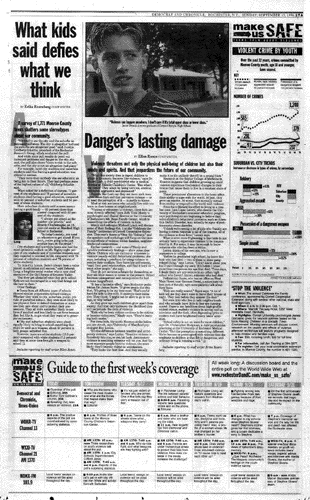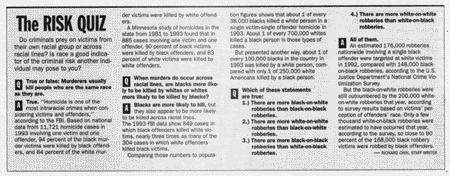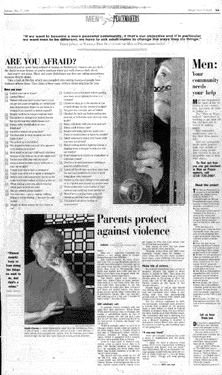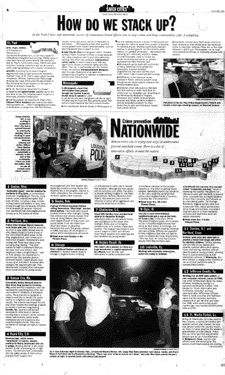| “Journalists who listen for quotes miss what’s being told to them.“ Cole Cambell, Editor, St. Louis Post-Dispatch Batten Symposium, September 13, 1995 |
Many of civic journalism’s tools are familiar: extensive research, good writing, graphics that attract and inform.
Some, however, are quite different. Journalists accustomed to battling their competitors in television may at first be uncomfortable about an alliance with the competition. But in city after city, those alliances have been powerful tools to focus public attention on important local problems.
Other tools essential to civic journalism are reporting and graphic techniques that help readers and viewers see their roles as active participants in solving a problem or dealing with an issue rather than as observers passively watching a controversy unfold in the news pages.
One way news organizations make their reports more involving is to build in opportunities for interaction. Newspapers and television stations used to be one-way pipelines of information to readers and viewers. Now, interactivity can be encouraged through all kinds of emerging communications technologies. Web sites, e-mail, voice mail, faxes and other electronic tools have made it possible to have two-way conversations, to involve citizens in the process of journalism.
Civic journalists, for instance, seek out the personal involvement of readers and viewers as sources of opinion and information, as participants in a community dialogue sponsored and sustained by the media, and as active partners in the search for solutions to community problems.
Aiding the interactive connections to readers and viewers are all the graphic tools of newspaper design and broadcast production techniques. Civic journalism often covers complex subjects over long periods of time. Effective graphic presentations help attract and retain readers and viewers.
BUILDING MEDIA ALLIANCES
 In Rochester, four media partners cooperated extensively in a series on teenagers’ attitudes about violence. This grid shows how the Democrat and Chronicle cross-promoted the alliance’s activities for the week. In Rochester, four media partners cooperated extensively in a series on teenagers’ attitudes about violence. This grid shows how the Democrat and Chronicle cross-promoted the alliance’s activities for the week.
|
Print and broadcast journalists have often interacted like the cobra and the mongoose. It doesn’t have to be that way. Numerous civic journalism projects have demonstrated how effective local media alliances can be when done carefully. The sharing of talent, the pooling of research and the cross-promotion of stories and broadcasts have a powerful leveraging effect on public attention. And, to the surprise of many journalists, citizens appreciate media cooperation on projects of community concern.
Alliances can include institutions outside the media.
 The Charlotte Observer used “About this Series” frequently to alert readers to what was coming from all the media partners. The Charlotte Observer used “About this Series” frequently to alert readers to what was coming from all the media partners.
|
In Myrtle Beach, S.C., The Sun News formed a partnership with the Center for Education and Community at Coastal Carolina University, and through workers there became part of an AmeriCorps grant to involve citizens in dealing with crime in local neighborhoods.
In Binghamton, N.Y., the Press & Sun-Bulletin and its media partners worked with Binghamton University (SUNY) in a project on economic recovery for the region. Similarly, the Journal Star in Peoria teamed up with Bradley University and Illinois Central College of Peoria for help with polling and analysis in a leadership series.
I n Sioux Falls, the Argus Leader recruited a University of South Dakota rural-entrepreneur to help coach the town of Tyndall as its citizens worked on strategies for community renewal. n Sioux Falls, the Argus Leader recruited a University of South Dakota rural-entrepreneur to help coach the town of Tyndall as its citizens worked on strategies for community renewal.
|
In California, the San Jose Mercury News editorial board found the public library system to be an ideal partner in its “Common Ground” initiative for convening conversations on such topics as affirmative action and education.
PERSONALIZING THE REPORT
Readers can be more than passive customers. They can be sources, experts, subjects and contributors. Civic journalism is alert to all these possibilities.
In St. Paul, editors of the Pioneer Press have learned to personalize their reporting in a variety of ways:
|
||
|
||
|
||
|
||
|
||
|
||
USING GRAPHIC DEVICES
Something old, something new. If civic journalism is new, the graphic devices that make its presentation effective are tried and true. They include grids, Q. & A. formats, charts, maps, and a host of inventive devices, large and small.
|
||
|
||
|
||
|
||
|
||
|
||
|
||
|
||

 As part of “Safer Cities,” a project on neighborhood crime, readers were given advice on specific steps they could take to contend with domestic violence.
As part of “Safer Cities,” a project on neighborhood crime, readers were given advice on specific steps they could take to contend with domestic violence.
 To help readers experience what it might be like to live in a high-crime neighborhood, a Pioneer Press reporter moved in and kept a diary.
To help readers experience what it might be like to live in a high-crime neighborhood, a Pioneer Press reporter moved in and kept a diary.
 The Dulath News-Tribune in its “Men as Peacemakers” project gave readers a mental checklist of the precautions they might take because they are afraid.
The Dulath News-Tribune in its “Men as Peacemakers” project gave readers a mental checklist of the precautions they might take because they are afraid.
 To personalize the story of ‘Courage” as part of its series on values, the Kansas City Star used citizens as sources and “experts,” The same device was used in a feature called “Living the Life.”
To personalize the story of ‘Courage” as part of its series on values, the Kansas City Star used citizens as sources and “experts,” The same device was used in a feature called “Living the Life.”
 As citizens begin to get involved, things start happening. The Observer kept up with people in Charlotte as they started “making a difference.”
As citizens begin to get involved, things start happening. The Observer kept up with people in Charlotte as they started “making a difference.”
 GRIDS:
GRIDS: Q & A FORMATS
Q & A FORMATS GRAPHS AND CHARTS:
GRAPHS AND CHARTS: FORMS AND COUPONS
FORMS AND COUPONS MAPS
MAPS FULL-PAGE SPREADS:
FULL-PAGE SPREADS: PROJECT INDEX:
PROJECT INDEX: WEB SITES:
WEB SITES: